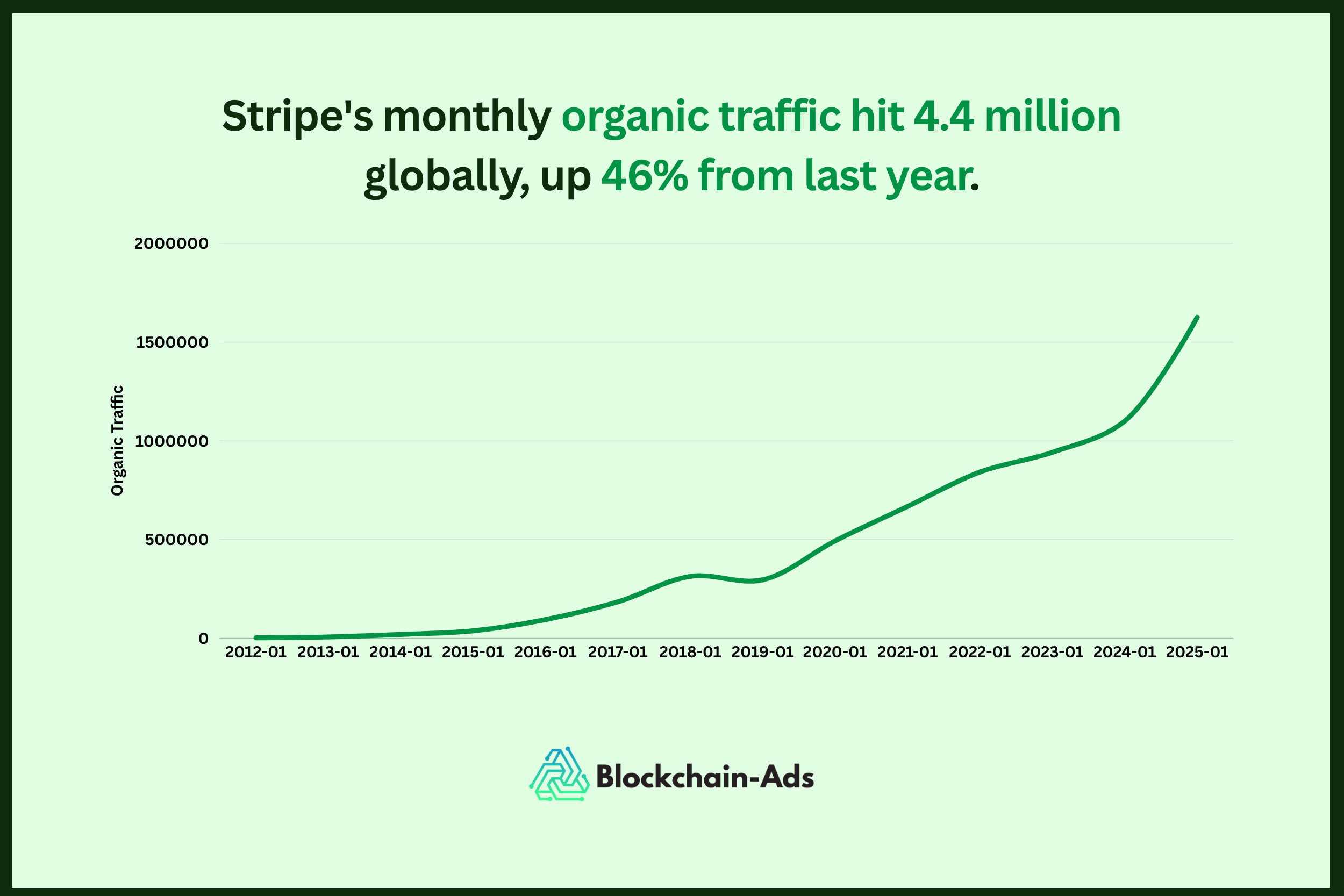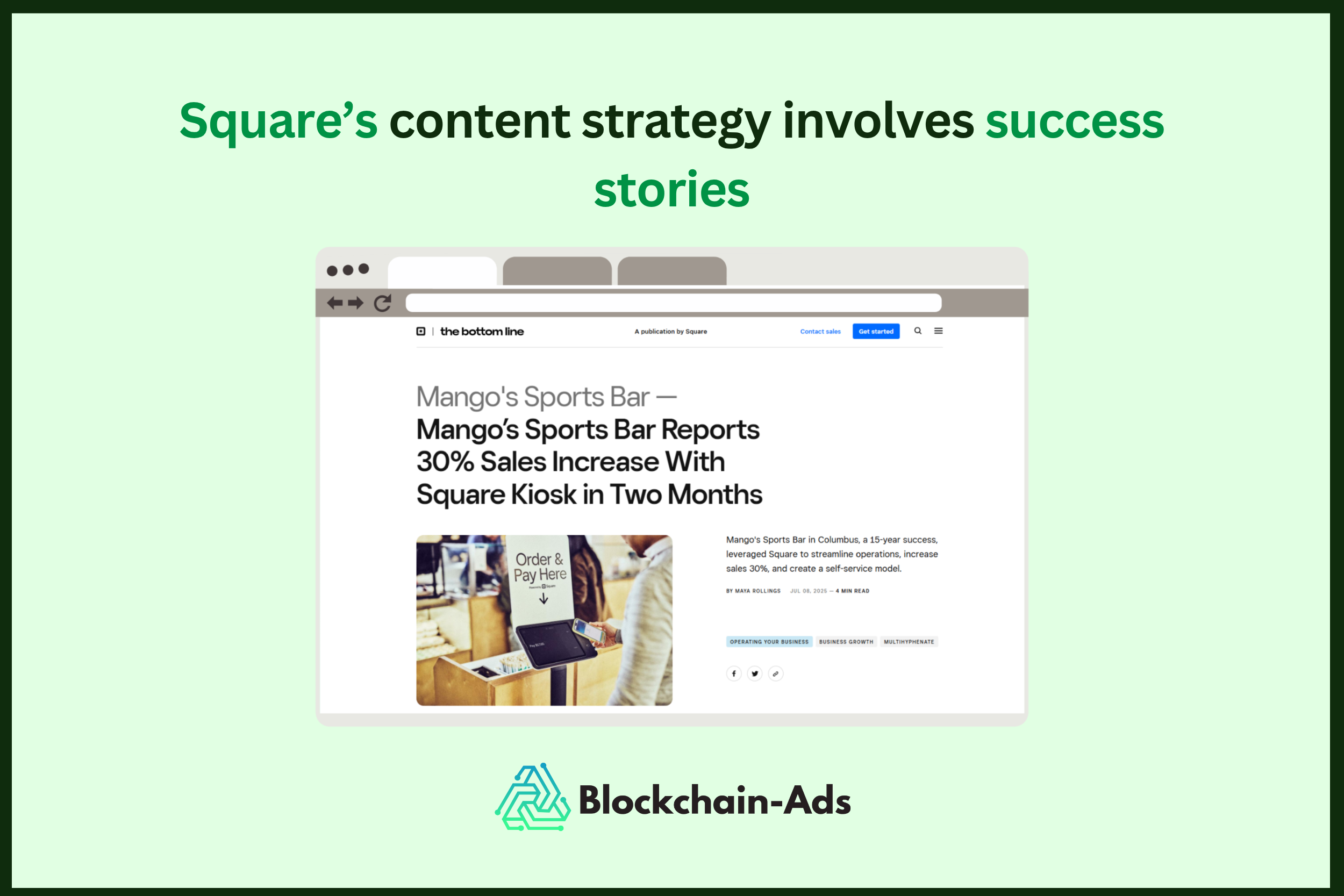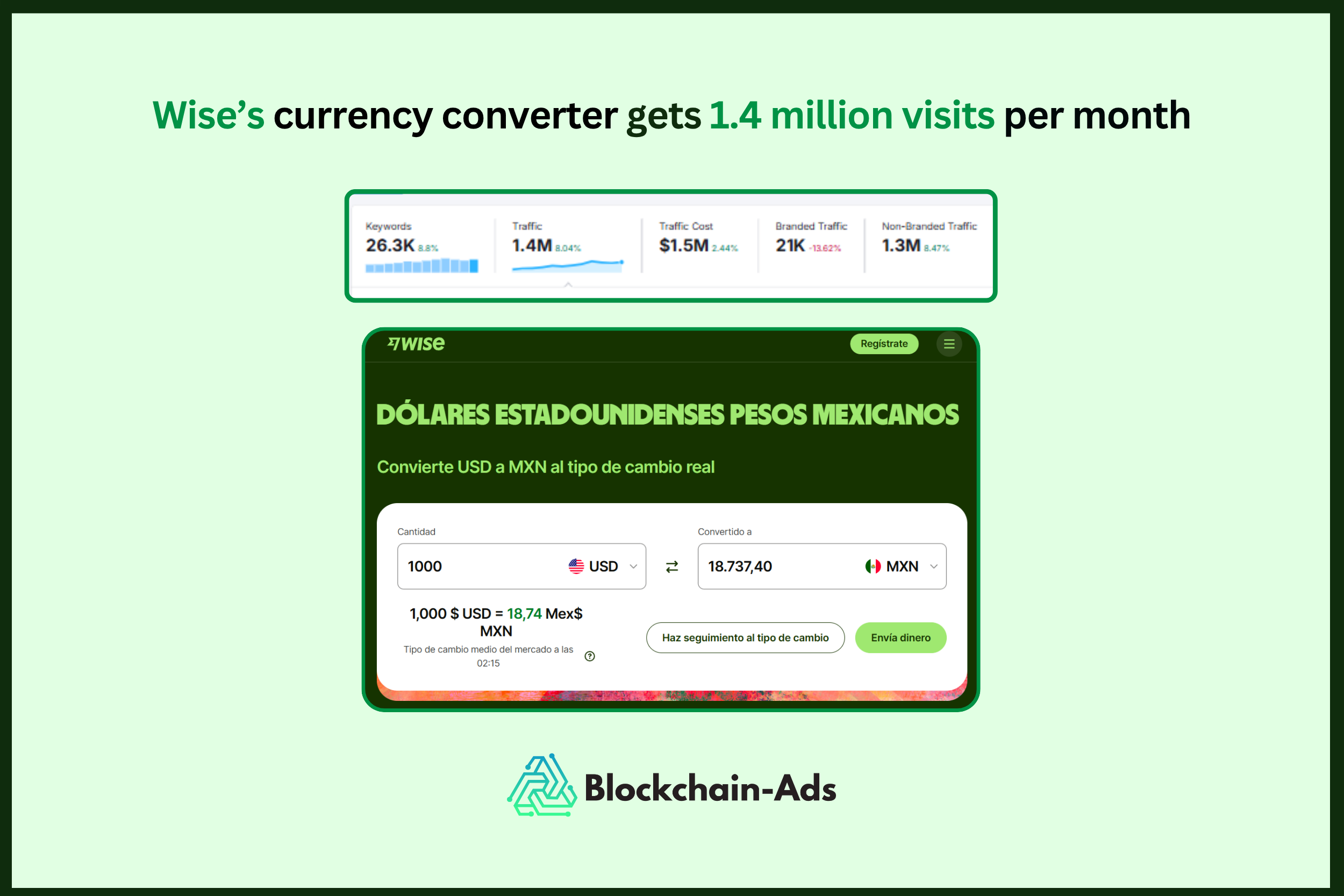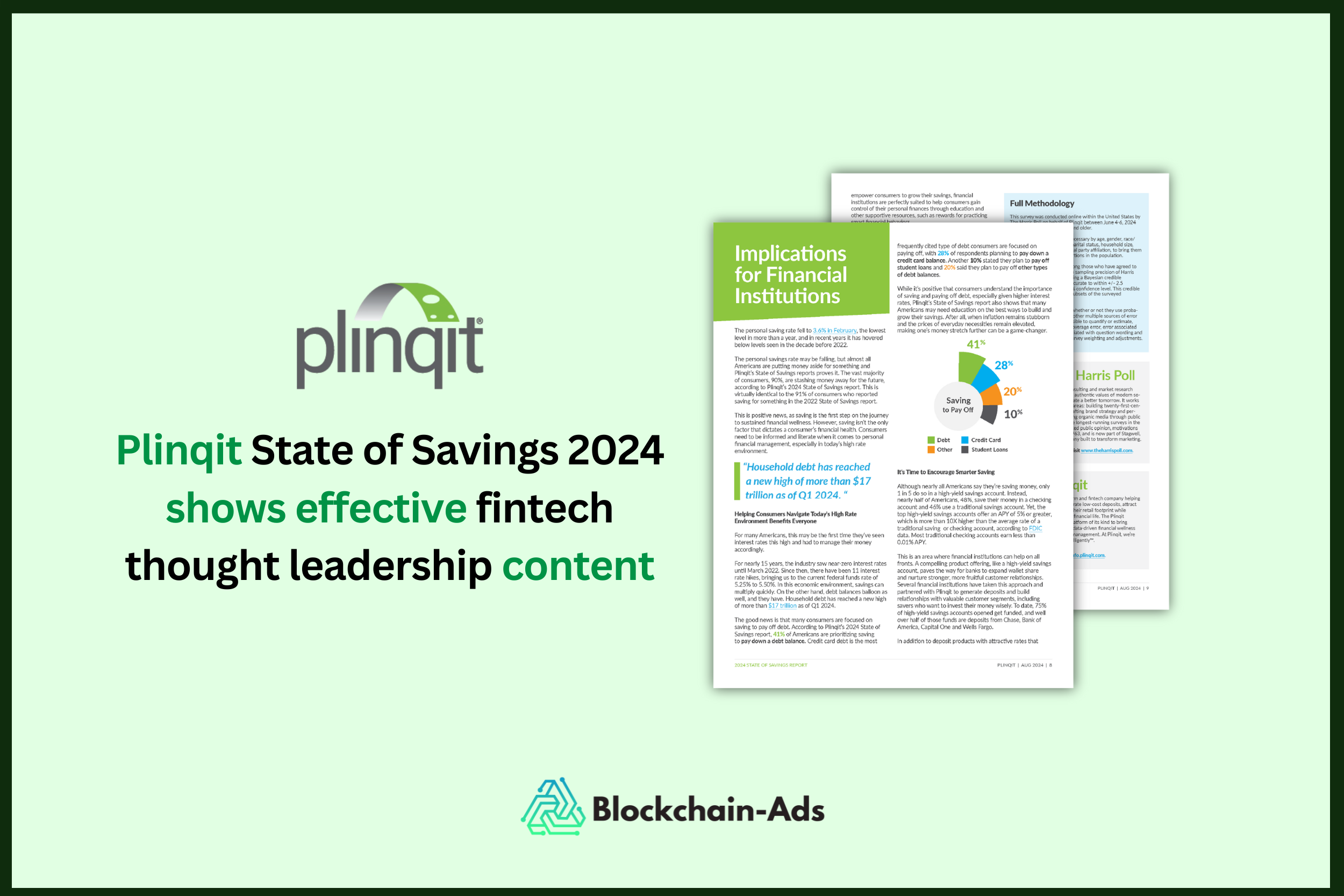6 Fintech Content Marketing Beispiele und Strategien
Überschrift
- Cointelegraph Formula bietet 8 Millionen monatlichen Lesern in über 190 Ländern verschiedene Anzeigenformate an und nutzt dabei seinen vertrauenswürdigen Namen in Sachen Krypto.
Etwa 96% der Top-Fintech-Unternehmen setzen auf Content Marketing, um Traffic zu steigern und Deals abzuschließen. Und es funktioniert. Fintech-Websites verzeichnen ein jährliches Wachstum des organischen Traffics von 35%. Dies ist ein klares Signal dafür, dass intelligenter Content sich auszahlt.
Der Wert von Content gilt branchenübergreifend, und das Finanzwesen bildet keine Ausnahme. Dennoch könnte es Ihnen schwerfallen, eine Fintech Content Marketing Strategie zu entwickeln, die TATSÄCHLICH Kunden anzieht.
Was ist ein großartiger Weg, um zu beginnen? Schauen Sie sich sechs Marketing-Strategien der Top-Fintech-Unternehmen an! Wir betrachten Zahlungs-Apps wie Wise und Handelsriesen wie Binance – die großen Player.
Lassen Sie uns zunächst Fintech Content Marketing definieren. Dies wird helfen, die Grundlage für die Beispiele und Strategien in diesem Leitfaden zu schaffen.
Was ist Fintech Content Marketing?
Fintech Content Marketing beinhaltet die Erstellung und das Teilen von wertvollen, relevanten und konsistenten Inhalten. Das Ziel ist es, eine spezifische Zielgruppe im Bereich der Finanztechnologie anzuziehen, zu engagieren und zu halten.
Diese Strategie zielt darauf ab:
- Markenbekanntheit aufzubauen.
- Thought Leadership zu etablieren.
- Profitable Kundenaktionen zu fördern
Fintech Marketing-Teams entwickeln Content-Strategien, um den spezifischen Bedürfnissen und Herausforderungen ihrer Zielgruppe gerecht zu werden. Dieser Content – schriftlich, audio oder video – hilft potenziellen Kunden dabei, selbstbewusst Fintech-Produkte oder -Dienstleistungen zu wählen.
Fintech-Unternehmen teilen diesen Content auch über verschiedene Plattformen:
- Blogs
- Website
- YouTube
- Andere Websites
- Apps
- Und mehr
Nach der Verteilung analysieren sie dann die Wirksamkeit des Contents. Sie tun dies, indem sie Web-Analysedaten verfolgen, wie Suchmaschinen-Traffic, Social Media Engagement und neue Kunden.
6 Fintech Content Strategien mit Beispielen
Im Folgenden sind sechs Fintech Content Strategien aufgeführt, die jeweils mit einem führenden Beispiel illustriert werden und zeigen, wie sie zum Erfolg beitragen.
1. Stripe: Blog-Beiträge & Bildungsartikel
Stripe hat eine starke Fintech Content Strategie rund um die Google-Suche aufgebaut. Ihr Content wird durch Nutzerintention angetrieben und deckt verwandte Finanzthemen ab, die ihre Zielgruppe interessieren.
Stripe konzentriert sich darauf, Fragen mit hoher Kaufabsicht zu beantworten, insbesondere rund um Zahlungsinfrastruktur. Die meisten Menschen, die diesen Content lesen, suchen nicht einmal speziell nach Stripe. Ihr Blog bietet:
- Anleitungen (z.B. "Wie man Kreditkartenzahlungen online akzeptiert")
- Konkurrenzartikel (z.B. "Wie man PayPal-Zahlungen akzeptiert")
- Erklärungen zu Finanzprozessen und Gebühren (z.B. "Wie lange dauern Überweisungen")
Dieser Ansatz macht Stripe zu einer Anlaufstelle, sogar für Menschen, die noch keine Kunden sind. Diese Strategie bringt etwa 1,5 Millionen Besuche pro Monat in den USA und 4,4 Millionen weltweit ein.

Ein herausragender Beitrag ist "ACH Zahlungen 101", der erklärt, wie Automated Clearing House (ACH) Überweisungen funktionieren. Dieser Artikel allein zieht etwa 50.000 monatliche Besucher an und brachte auf seinem Höhepunkt fast 90.000 Besucher pro Monat ein.
Hier ist, warum diese Fintech Content Strategie funktioniert: Stripe findet Menschen, die sich über ACH-Zahlungen informieren, was für sie eine Herausforderung darstellen könnte. Dann zeigt Stripe dabei sein Wissen und seine Zahlungslösungen.
Stripes Bildungsartikel bieten klare Erklärungen und praktische Tipps. Sie verwenden auch ein SEO-freundliches Format, das dabei hilft, die Suchmaschinenplatzierungen zu verbessern.
2. Square: Fallstudien und Erfolgsgeschichten
Squares Fintech Content Marketing Strategie konzentriert sich darauf, Kundenerfolgsgeschichten zu teilen. Diese Geschichten heben hervor, wie Händler Squares Tools nutzen, um ihre Geschäfte zu erweitern. Diese Geschichten sind nachvollziehbare Erzählungen, die das Vorher vs. Nachher der Einführung von Squares Plattform zeigen.
Ein herausragendes Beispiel ist die "Poor George" Boutique-Fallstudie. Square hebt hervor, wie Poor George die Online-Verkäufe um 20% steigerte, nachdem Square Online integriert wurde. Es wird auch diskutiert, wie das Unternehmen die Abläufe mit Square Payroll und mehr optimierte.
Ein anderes Beispiel: Mango's Sports Bar meldet einen 30%igen Umsatzschub in nur zwei Monaten mit Square Kiosks. Diese Geschichten enthalten:
- Messbare Ergebnisse
- Eigentümerzitate
- Visueller Beweis für Square Tools in Aktion

Diese Art des Storytellings bietet einen doppelten Nutzen:
- Schafft eine emotionale Verbindung, wodurch die Leser sich selbst in der Geschichte wiedersehen.
- Liefert messbare Ergebnisse, wodurch Squares Wert in klaren Begriffen bewiesen wird.
Diese Fallstudien fungieren als Mid-Funnel Fintech Content Strategien. Sie können sie in E-Mail-Nurturing oder während Verkaufsgesprächen verwenden, wenn Interessenten Beweise benötigen. Square hilft Unternehmen dabei, Vertrauen zu gewinnen und zu konvertieren, indem sie den Erfolg anderer wie ihnen hervorheben.
3. Binance: Video Content und Webinare
Binance, eine der weltweit größten Krypto-Börsen, nutzt Video als zentrale Fintech Content Strategie. Krypto kann einschüchternd sein, daher setzt Binance auf Videos, um zu bilden, zu vereinfachen und Nutzern beim Einstieg zu helfen.
Binance betreibt zwei große YouTube-Kanäle:
- Binance Academy: Fokussiert auf Tutorials und Erklärungen
- Haupt-Binance-Kanal: Webinare, Live-Events und Updates für aktive Trader und die breitere Krypto-Community
Ihr Content performt gut. Die Binance Academy hat 173.000 Abonnenten, über 267 Videos und fast 8 Millionen Views. Ihr beliebtestes Video, "Wie man einen Stop Limit verwendet", hat über 1 Million Views und zeigt eine starke Nachfrage nach anfängerfreundlicher Anleitung.

Binances Haupt-YouTube-Kanal hat jetzt über 1 Million Abonnenten. Dies zeigt eine starke globale Nachfrage nach bildenden und community-fokussierten Krypto-Inhalten.
Binances Video Content Strategie funktioniert, weil sie Barrieren für neue Nutzer abbaut und Vertrauen aufbaut. Video-Erklärungen vereinfachen Krypto-Tools für Nutzer, und Webinare halten sie engagiert.
Binance nutzt auch Performance-Werbung auf Blockchain-Ads mit beeindruckenden Ergebnissen.
4. Wise: Datenreiche Inhalte & Tools
Wise (ehemals TransferWise) hat eine der effektivsten Fintech Content Marketing Strategien rund um datengetriebene Tools aufgebaut, die unmittelbare Nutzerbedürfnisse lösen. Wise erhält weltweit jeden Monat 166,9 Millionen Besuche. Dies gelingt durch die Kombination nützlicher Tools mit lokalen, SEO-freundlichen Inhalten.
Ihre Währungsumrechner-Seiten sind ein herausragendes Beispiel. Diese Seiten zeigen Live-Wechselkurse, erklären, wie Gebühren berechnet werden, und bieten genau das, wonach Nutzer suchen.
Diese Strategie generiert enormen Traffic: eine einzige Seite, "mil dólares estadounidenses a pesos mexicanos", bringt allein 1,4 Millionen Besuche pro Monat ein.

Ein Teil dessen, was dies funktionieren lässt, ist die Lokalisierung. Wise erstellt spezielle Seiten für verschiedene Sprachen, Währungen und Märkte. Dies hilft ihnen dabei, für spezifische, kaufintensive Suchanfragen weltweit zu ranken.
5. Plinqit: Thought Leadership und Originalforschung
Plinqit, ein Fintech für persönliches Sparen, zeigt, wie kleinere Player Thought Leadership nutzen können, um Autorität aufzubauen. Ihre Strategie konzentriert sich auf Originalforschung, die echten Wert für Verbraucher und Branchenteilnehmer bietet.
Ein herausragendes Beispiel ist ihr 2024 State of Savings Report. Plinqit arbeitete mit The Harris Poll zusammen, um mehr als 2.000 US-Erwachsene zu ihren Spargewohnheiten und -herausforderungen zu befragen. Das Ergebnis war ein umfassender Bericht, der im Mittelpunkt ihrer Thought Leadership-Bemühungen stand.
Nach dem Launch des Berichts verzeichnete Plinqit:
- Eine 375%ige Steigerung der Redneraufträge
- Einen 162%igen Anstieg des Website-Traffics
Der Bericht gewann Plinqit auch den FinTech Marketing North American Award for Best Use of Thought Leadership.

Diese Fintech Content Strategie ist erfolgreich, weil Plinqit auf vertrauenswürdige, exklusive Daten setzte. Dieser Ansatz etablierte sie als Experten für Verbraucherspargewohnheiten.
Der Bericht löste eine breite Content-Kampagne aus. Diese umfasste Blog-Beiträge, Infografiken, Webinare und mehr. Er zog auch PR-Aufmerksamkeit und Brancheneinladungen auf sich.
Plinqit zeigt, dass Fintech-Marken mehr als nur Produkte bewerben können. Sie können Content-Strategien umsetzen, die Kunden bilden, Vertrauen aufbauen und ihre Markenreichweite erweitern.
6. Klarna: Social Media und Influencer Content
Klarnas Fintech Content Marketing Strategie konzentriert sich auf Social Media und Influencer-Partnerschaften. Diese Strategie steigert die Bekanntheit und hält sie mit aktuellen kulturellen Trends verbunden.
Ein großartiges Beispiel ist ihre Zusammenarbeit mit Paris Hilton bei der "That's Smoooth" Kampagne. Klarna ging über Werbung hinaus. Sie erstellten unterhaltsamen Social Content, der perfekt zu TikTok und Instagram passt. Es zeigt klar, wie einfach und flexibel Klarnas Zahlungen sind.

Das ist auch nichts Neues für Klarna. In der Vergangenheit arbeiteten sie mit Snoop Dogg (oder "Smoooth Dogg") zusammen, um dieselbe Botschaft zu vermitteln: Klarna ist cool, unterhaltsam und reibungslos.
Diese Strategie funktioniert durch die Kombination von Prominenten-Vertrauen mit Nutzer-Content. Sie hilft Klarna dabei, sich mit jüngeren Zielgruppen zu verbinden und ermutigt sie dazu, ihre eigenen "smoooth" Shopping-Geschichten zu teilen. Es ist ein Fintech Content Ansatz, der Finanzen sozial, ansprechend und gesprächsfördernd macht.
Vorteile von Fintech Content Marketing
Fintech Content Marketing zieht strategisch Kunden an, bildet sie aus und konvertiert sie in einem 340,10 Milliarden Dollar Markt. Hier ist, wie dieser Ansatz wirklich liefert.
Neue Zielgruppen anziehen
Verbraucher sind überwältigt von Online-Finanzinformationen. Für Geldentscheidungen – wie Überweisungen oder Gebühren – sehnen sie sich nach klaren, vertrauenswürdigen Anleitungen. Hochwertiger Fintech Content sorgt dafür, dass Marken erscheinen, wenn Menschen suchen.
Zum Beispiel bevorzugen 70%, durch Artikel zu lernen anstatt durch Werbung. Unternehmen wie Stripe und Wise beweisen dies; Wises lokalisierte Inhalte, die alltägliche Fragen beantworten, ziehen monatlich Millionen an.
Wertvolle, umsetzbare Ratschläge bieten
Finanzen erscheinen oft komplex und hindern informierte Entscheidungen. Fintech Content Marketing vereinfacht dichte Themen in ansprechende Videos, Infografiken und Blog-Beiträge für alle Finanzbildungsniveaus.
Diese Strategie erweitert sich über traditionelle Finanzen hinaus. Während der Pandemie führten Lifestyle- und Wellness-Inhalte das Fintech-Zielgruppen-Engagement an und spiegelten breitere finanzielle Sorgen wider. Diese Vielfalt hält Marken relevant und verbindet sie mit Kunden in jeder Lebensphase.
Vertrauen und Thought Leadership etablieren
Im Fintech ist Vertrauen von größter Bedeutung. Konsistenter, gut recherchierter, zeitgemäßer Content positioniert ein Unternehmen als glaubwürdige Autorität. Diese Thought Leadership baut Loyalität auf und zieht Zielgruppen sowohl für Content als auch für Dienstleistungen zurück.
Plinqits 2024 State of Savings Report veranschaulicht dies mit dem 162%igen Anstieg des Website-Traffics des Unternehmens. Das ist Content Marketing, das Autorität und Ergebnisse vorantreibt.
Leads und Conversions fördern
Letztendlich befeuert Fintech Content Marketing das Unternehmenswachstum. Content bildet Interessenten vor dem Kauf aus, führt sie durch den Funnel und baut Produktvertrauen auf. Forschung zeigt, dass Content Marketing dreimal mehr Leads bei 62% niedrigeren Kosten als Outbound Marketing generiert.
Jeder hilfreiche Blog-Beitrag oder Leitfaden fungiert als Einstiegspunkt und führt Menschen zur Conversion.
Aufbau einer starken Fintech Content Strategie
Nicht alle Content-Strategien sind gleich. Eine solide Fintech Content Strategie hilft Nutzern dabei, von der Entdeckung zur Entscheidung zu gelangen. Es geht um mehr als nur Traffic zu generieren.
1. Ihre Zielgruppe tiefgreifend verstehen
Fintech-Zielgruppen sind vielfältig, von neuen Sparern bis hin zu Unternehmens-CFOs. Um eine Verbindung herzustellen, müssen Sie sie tiefgreifend kennen. Erstellen Sie klare Personas, um ihre finanziellen Herausforderungen, Ziele und ihr Wissen zu targetieren.
Das bedeutet, ihre Fragen, Barrieren und wo sie online sind zu verstehen. Top-Fintech Content Marketer personalisieren Nachrichten für spezifische Segmente und stellen überall Relevanz sicher.
2. Echte Probleme lösen
Ihr Content sollte helfen, nicht nur informieren. Der effektivste Fintech Content antizipiert Nutzerschmerzen und liefert praktische Antworten. Ob es darum geht, ACH-Zahlungen zu erklären (wie Stripe) oder Währungsumrechnungskurse zu vergleichen (wie Wise), Content muss sofort nützlich sein. Dieser Fokus zieht Leser an und verdient Vertrauen als Anlaufstelle.
3. Auf allen Ebenen bilden
Bildung ist der Schlüssel im Fintech. Starke Content-Strategien erkennen verschiedene Wissensniveaus an. Schließen Sie Anfängerleitfäden, fortgeschrittene Erklärungen und Thought Leadership ein. Diese Mischung bietet allen Wert, egal wo sie in ihrer finanziellen Reise stehen.
4. Konsistent Autorität demonstrieren
Thought Leadership braucht Zeit, zahlt sich aber aus. Das Teilen von Experteneinblicken, Originalforschung oder klaren Analysen macht Ihre Fintech-Marke glaubwürdig. Plinqits Sparbericht führte zu mehr Traffic und hob ihr Profil in der Branche.
Konsistenz ist jedoch der Schlüssel. Autorität aufzubauen bedeutet, regelmäßigen, nützlichen und zuverlässigen Content bereitzustellen. Es reicht nicht aus, sich auf eine einzige große Kampagne zu verlassen.
5. Externe Ressourcen nutzen, wo wertvoll
Content-Erstellung erfordert Ressourcen, und Fintech-Teams arbeiten oft schlank. Die Zusammenarbeit mit vertrauenswürdigen Publishern, die Lizenzierung großartiger Artikel oder das Teilen Ihres besten Contents kann Ihre Reichweite und Glaubwürdigkeit steigern. Die Assoziation Ihrer Fintech-Marke mit vertrauenswürdigen Namen im Finanz- oder Wirtschaftsjournalismus steigert schnell die Glaubwürdigkeit. Dies funktioniert oft besser als Content allein.
Fazit
Eine effektive Fintech Content Strategie konzentriert sich auf den Kunden. Sie löst Probleme, bildet klar aus und baut Autorität auf. Außerdem skaliert sie intelligent durch externe Partnerschaften.
Wenn richtig gemacht, kann sie langfristiges Wachstum vorantreiben. Der effektivste Ansatz paart Content Marketing mit anderen Fintech Marketing Strategien. Diese Fusion von Content Marketing und anderen Strategien kann Ihrer Fintech-Marke dabei helfen, der Konkurrenz voraus zu bleiben.
Qualifizieren Sie sich und erhalten Sie Zugang zu Blockchain-Werbung
Lorem ipsum dolor sit amet, consectetur
Schnelle Definition

Sprechen Sie mit einigen unserer aktuellen Partner
Alle Erfolgsgeschichten ansehen

Erreiche 12M+
Engagierte Web3-Nutzer auf über 10.000 Websites und 37 Blockchains.






.avif)
.png)





